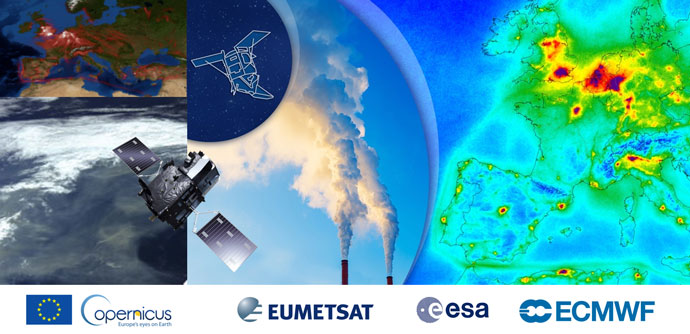An intensive week of engaging lectures by leading atmospheric scientists and hands-on practical sessions in the analysis of satellite data and derived products took place from 16 to 20 November. The event was the second training course on atmospheric composition organised jointly by the European Organisation for the Exploitation of Meteorological Satellites (EUMETSAT), the European Space Agency (ESA) and ECMWF through the Copernicus Atmosphere Monitoring Service (CAMS). It followed a first joint course on atmospheric composition in Cluj, Romania, in November 2019.
Structure and content
The objectives of the training were to present the state of the art in air quality monitoring; to provide an overview of observations, modelling, data assimilation and applications; and to enhance the capacity to access and analyse data. The training course also aimed to foster collaboration amongst participants and encourage the development of individual and team projects using the data, resources and methodologies presented.
Thirty early career scientists and data users, from 20 countries and from both academia and industry, attended the training. A good gender mix was achieved with 12 female and 18 male participants. These were mainly from the member states of the hosting agencies, including associated states, but a few were from other countries to ensure a geographical mix and to encourage the exchange of ideas and networking.

The training took place entirely online, with the mornings dedicated to lectures and discussion sessions, and the afternoons to hands-on practicals. The lectures covered satellite missions and instruments, in-situ networks, trace gas and aerosol retrievals, data assimilation and modelling. These were given by experts from universities, research institutes, space agencies and private industry. ECMWF staff who contributed to the lectures include Vincent-Henri Peuch, Antje Inness, Jérôme Barré and Mark Parrington, with Miha Razinger leading some of the practical sessions. The lectures were publicly streamed on YouTube and accessible to everyone, not only to the 30 selected course participants.
For the practical sessions, participants were divided into smaller groups. The first practical included a primer on the basics of pollution, remote sensing and modelling. On the following two afternoons participants chose between parallel sessions on satellite data processing for atmospheric composition analysis, CAMS data discovery, and exploration of the HARP toolbox. These sessions were carried out using Jupyter Notebooks, with each participant provided with an account on a dedicated JupyterLab environment set up specifically for the training.
On the last two days participants were given the task to develop their own case studies, either individually or in groups. Results were presented at the end and shared on the online wall board, Padlet, to invite comments and stimulate discussion. Some fascinating case studies of participants included analyses of recent events, such as aerosol and trace gas emissions from the California fires, the Raikoko volcano eruption or biomass burning in Australia, using a combination of reanalysis data from CAMS or satellite measurements from instruments such as GOME-2 and TROPOMI. In some cases participants tested the limits of resolution to detect e.g. shipping lanes from atmospheric constituents, or to compare trace gas concentrations over certain European cities before and after the lockdown due to the COVID‑19 pandemic. Equally interesting case studies included an analysis of long-range transport of aerosols, a comparison of satellite observations with in-situ measurements, and others.
Feedback
Overall feedback from the course was very positive with participants considering it to be relevant, useful, and with an appropriate balance between theoretical lectures and hands-on practicals. In addressing the fully online nature of the course, participants highlighted the advantages of saving costs in travel and accommodation, and the convenience of tools such as Zoom, Sli.do, Slack and Padlet. However, despite all the efficiencies of online training, participants were almost unanimous in their opinion that they cannot substitute the level of interaction that can be had with face-to-face events.
For more information on the event, please visit https://training.eumetsat.int/course/view.php?id=387.
Participant feedback
“I discovered new commands and the environment of Jupyter that will absolutely enhance my capabilities for data processing. Amazing work!”
“It was great to be given ‘recipes’ for dealing with the various datasets. This was my expectation of the course and it was met.”
“This course has been great, also because it has shown the possibility to have lectures, practical sessions and interactions online, something that was hard to believe just a few months ago!”

